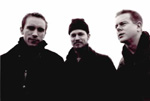| |
FME
(Vandermark / McBride / Nilssen-Love)
Chicago IL, 3 December 2003
by Jay Collins
January 2004
 On a Wednesday
evening in early December, Ken Vandermark brought his FME Ensemble
to Chicago's venerable hole in the wall, The Empty Bottle. Although
not originally planned as an improvised music venue per se, Vandermark
and critic/producer John Corbett have been curating a series at this
Ukrainian Village spot for a few years now. Not only has the arrangement
brought in top-notch guests from all over the globe, but also has
provided Vandermark with a space to workshop his projects in front
of the public (the Tuesday night gigs, among others). On a Wednesday
evening in early December, Ken Vandermark brought his FME Ensemble
to Chicago's venerable hole in the wall, The Empty Bottle. Although
not originally planned as an improvised music venue per se, Vandermark
and critic/producer John Corbett have been curating a series at this
Ukrainian Village spot for a few years now. Not only has the arrangement
brought in top-notch guests from all over the globe, but also has
provided Vandermark with a space to workshop his projects in front
of the public (the Tuesday night gigs, among others).
Unfortunately for his hometown, Vandermark's growing fame abroad has
been tough on regular visitors to the Bottle, which can be a fantastic
place to see a show. Despite the usual concert-going negatives, such
as an excess of smoke and the obnoxious sorts that seem unable to
zip it during the performance (especially on the quieter numbers),
the Bottle allows the performers a relaxed atmosphere that encourages
an intimate view for the attendees. Indeed, the musicians perform
right on the floor, on the same level as the crowd (and not on the
risers, which are saved for "big name" shows).
As for FME, it was the ensemble's kickoff of a ten-date North American
tour and as such, the group was charged up and ready to play. It is
perhaps Vandermark's most "free" collective, an ode
to FMP (Free Music Productions) and SME (Spontaneous Music Ensemble)
that fittingly focuses on sound exploration and abstract moods. However,
before one might think that the approach is balls to the wall energy
or pure abstraction, the various personalities combine into a singular
mix of free-time principles and jagged vamp-based structures.
What was particularly exciting was the fact that drummer Paal Nilssen-Love
was present, after sitting out the group's last tour due to illness.
While Vandermark 5 and Triage drummer Tim Daisy did his best to fill
the Norwegian's huge shoes, Nilssen-Love brings a special dynamism
to the proceedings that is integral to this unit. Rounding out the
trio, of course, is Vandermark's frequent collaborator and old Beantown
cohort, bassist Nate McBride. As for the performance specifics, the
group presented two sets at around forty-five minutes per set, where
a continuous flow of music was encouraged, despite a brief break for
air midway through each offering.
The group opened the first set with a new piece "Kiosk",
an energized free-swing number with unison lines from McBride and
Vandermark at its inception. After a few moments, Nilssen-Love hit
his stride, alternating between free rhythms and variable patterns.
Vandermark soon soared into the stratosphere with blazing altissimo
runs to match Nilssen-Love's whirlwind drumming, a signal that this
journey was to be thrilling. After the initial wallop, a bass/clarinet
duet emerged, encouraging the investigation of space, forged through
McBride's skilled arco musings. The light once again shone on Nilssen-Love,
who demonstrated his dexterity and timbral investigations during a
solo piece ("E Corce") that set up the excellent "Stran",
both of which appeared on the group's excellent Live At The
Glenn Miller Cafe release on Okka Disk. McBride's rubbery bass
and Nilssen-Love's groove encouraged the eventual eruptive discourse
impelled by Vandermark's poignant tenor work, sparring with the drummer's
cowbell accents and the bassist's spidery feeds. The wistful tones
of "Mir" soon followed, with a focus on melody urged by
Vandermark and McBride, with the latter taking an extended bass solo.
"Kopstoot" concluded the set with Vandermark's caustic baritone
lines going head to head with Nilssen-Love in a rapturous exchange
that left the crowd with their mouths open.
The second course of the evening was served up in a similar fashion,
emphasizing the contrast between unrestrained and fervent configurations,
Vandermark's reed arsenal and the symbiotic connection between
these players. A textural piece began the set that emphasized Vandermark's
emotive bass clarinet. On the other hand, the next piece was an intense
baritone sax/drums duet, similar to "Kopstoot", that eventually
brought McBride's flexible and dancing arco work to the spotlight.
Changing course yet again, McBride and Vandermark (on clarinet) engaged
in a melodic interchange that was followed by the elongated crescendo
of a tenor-driven group romp ("Sono"). Finally, in contrast
to the intensity that had come before, the show concluded with a melancholic
piece guided to its concluding moments via Vandermark's sonorous bass
clarinet.
In sum, FME demonstrated a fine display of high-level interaction,
with a fitting amalgamation of various influences that favored freewheeling
vigor and subdued instances of investigation. This is indeed one of
Vandermark's finest groups, which is saying something.
|
|
|
|
|

